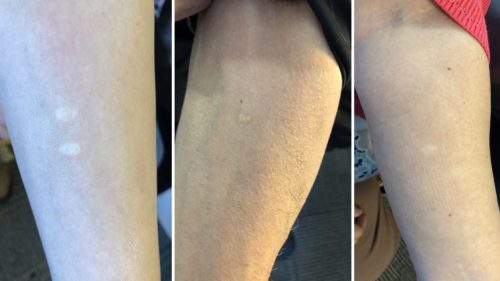One of the methods used to measure in-breeding in cheetahs was to to do skin grafts. Transplant a small patch of skin from one animal to another, and if there was no tissue rejection, then they were likely to be genetically similar. Those were routine experiments done on animals, where you don’t need to explain to the subject why you’re doing these bizarre experiments.
I guess some scientists in the 1970s thought Inuit were equivalent to experimental animals, because they were doing the same thing without getting informed consent.
Nearly 50 years ago, the hamlet of Igloolik was the site of a boom in scientific research, all part of a larger project called the International Biological Program. While the program was aimed at answering a wide array of scientific questions, much of the work in Igloolik focused on Inuit.
“We would do all these different kinds of things for a researcher,” said former Nunavut premier Paul Quassa, who grew up in Igloolik.
In the early ’70s he was a young man, spending his days going to school and hunting. He remembers researchers being in the community and doing experiments — he says some were merely inconvenient and annoying, but others were more invasive.
Quassa remembers being taken to a research building with his uncle and his cousin. There, they were told to roll up their sleeves.
“They took pieces of our skin, from another person, and then they put into ours,” said Quassa.
“They had a little circular knife or blade, and they would just start twisting it and then you could see the skin being cut in a circle.”
I don’t do experiments on people, but I would think a fundamental principle of basic bioethics is that you would explain what you were doing, why you were doing it, and you would share the results with your subjects. These researchers don’t seem to be aware of the concept.
“It was an earlier time,” I can hear the science advocates saying. It was only 50 years ago! Scientists were well aware of the controversy of the Tuskegee project — news of that horror broke in 1972. Anyone doing research on human subjects should have known about it.
It’s estimated that researchers did the skin grafting experiment on more than 30 Inuit from Igloolik, including Lazarie Uttak.
“I was grafted with part of the skin of my sister,” said Uttak. “I feel like we were being used.”
Uttak, 67, still lives in Igloolik and says at least 15 of the people who were experimented on are still alive in the hamlet today.
“We talk about this sometimes,” he said. “It was really unfair. We never got any information from them about why this was happening and the reason why they did it. I never found out.”
We know the name of one of the researchers, Dr John Dossetor.
Dossetor was a professor of medicine at the University of Alberta at the time. He went on to become an expert in medical ethics.
In his book, Dossetor writes that his research in Igloolik received “community consent,” which he said was granted by elders via a non-Inuk translator. At the time Dossetor felt that was sufficient.
What the hell is “community consent”? Does that mean that the mayor of Morris, Minnesota could tell a researcher that it’s OK to do experiments on me? I think the problems with that idea are obvious. They sure are obvious to the Inuit subjected to these experiments.
Quassa shot back at the doctor’s concept of “community consent.” He questions what details were actually shared with locals in Inuktitut, and dismissed the idea that elders could unilaterally grant consent for invasive medical procedures.
“I’ve heard of scientists doing experiments on monkeys — they use animals to do a lot of experiments for the betterment of humankind,” he said.
“We are not monkeys, we are not animals, we are another human being that deserves respect.”
Now I’m wondering what experiments are being done on isolated communities here in the ’20s that will be revealed in the 2070s that will horrify everyone, and whether they’ll try to defend themselves by saying that we didn’t know better in 2020.
You know, we do.



Holy sh$#%! . First Tuskeege and now this.
Here’s another: https://www.ctvnews.ca/canada/victims-of-alleged-lsd-brainwashing-experiments-in-montreal-plan-to-file-lawsuit-1.3938614
Hey, Humans! Your species has issues!
Say after me: “REAL PEOPLE ARE NOT LIKE THE IGOR CLAN”.
Since unlike cheetahs one can simply ASK an Inuit person who their ancestors were, I would think it would be cheaper and easier to work out consanguinity that way. Did no advisor, supervisor, or grant approver of this project point that out?
I remember finding out how the Salk team tested their polio vaccines. They injected a bunch of children in orphanages. After all, since they don’t have families, nobody will be too sad if you kill a few orphans. And this was just a few years before I was born.
Maybe beyond readin’, ritin’, and ‘rithmatic, morality should become a required subject in school. We sure as hell can’t count on the churches to teach it.
I forwarded this to a friend of mine who lives in Alaska, and she responded “Yeah. It explains why certain groups resisted the covid vaccine. They thought it was another experiment”.
What the fuck, man?
You’d think we’d have learned a little something from Tuskeegee, but apparently we took all the wrong lessons from that atrocity.
Also, the irony: “[Dosseter] went on to become an expert in medical ethics.“
Tuskeegee didn’t end until 1972 and I don’t think anybody ever got into trouble for it.
Never mind Tuskeegee; had these people never heard of Mengele?
Not quite comparable, lucifersbike.
Yes, there are historical episodes like https://en.wikipedia.org/wiki/Unit_731
This is not about torturing people to death.